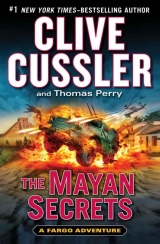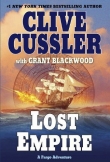
Текст книги "The Mayan Secrets"
Автор книги: Clive Cussler
Жанр:
Морские приключения
сообщить о нарушении
Текущая страница: 6 (всего у книги 20 страниц)
They went back upstairs, and Remi said to Selma, “Are all the new security systems up and running yet?”
“Yes.”
“Good. But don’t sleep here tonight. Arm all the systems and go to your apartment. We’re going to have a break-in tonight.”
It was only quarter to eleven, so Sam and Remi drove to the campus of the University of California, San Diego. They found a parking structure not far from the Anthropology Department, then walked there.
As they approached David Caine’s office, they saw the door open and a male student leave his office, looking down at a paper and frowning. Caine said to the student, “Just get the bibliography and notes in shape before you hand it in.” Then he saw the Fargos. “Sam! Remi! What’s up?” He beckoned them into his office and shut the door, then moved piles of books off chairs for them. “I thought we were going to meet at your house.”
Sam said, “We had a visit about an hour ago from a woman named Sarah Allersby.”
“You didn’t.”
“You know her?” asked Remi.
“Only by reputation.”
Sam said, “She’s apparently been fed information by at least one of the colleagues you spoke with. She offered us seven million dollars for the codex. She knew what was in it.”
“Oh, no,” he said. “I only spoke with people I thought I could trust. I never took into account the sort of temptation a person like that can offer.”
“What do you know about her?” asked Remi.
“More than I want to. She’s one of a whole class of people who have been filling gigantic houses in Europe and North America with pilfered artifacts for over a hundred years. They used to travel to undeveloped countries in the nineteenth century and take what they wanted. In the twentieth century, they paid galleries huge prices for objects that grave robbers dug up. By buying some, they created a market for more. They couldn’t be bothered to wonder what some object really was, where it came from, or how it was obtained. As things stand today, if I were in a hurry to find the most sacred objects in existence, I wouldn’t dig for them and I wouldn’t search in museums. I’d look in the homes of people in Europe and America whose families have been wealthy for the last hundred or so years.”
“Is that the Allersbys?” asked Remi.
“They’re among the worst,” Caine said. “They’ve been at it since the British arrived in India. It wasn’t even frowned upon until about thirty years ago. Even now, if an object left its country of origin before the United Nations treaty signed in the 1970s, you can do anything you want with it – keep it, sell it, or put it in your garden as a birdbath. That loophole exists because rich people like the Allersbys exerted influence on their countries’ governments.”
“Sarah seemed pretty comfortable with the idea that we’d smuggled the codex out of Mexico for sale,” said Remi.
He shook his head. “It’s ironic. I’ve heard the British tabloids spend a lot of ink on her bad behavior in the Greek islands and the French Riviera. But what she does in Guatemala is worse and it’s serious.”
“Why?”
“Guatemala had a civil war between 1960 and 1996. Two hundred thousand people died in that war. A lot of the old Spanish landowning families sold out and moved to Europe. The ones who bought those huge stretches of land were mostly foreigners. One of them was Sarah Allersby’s father. He bought a gigantic place called the Estancia Guerrero from the last heir, who had been living high in Paris and gambling in Monaco. When Sarah turned twenty-one, her father settled a lot of property on her – buildings in several European capitals, businesses, and the Estancia Guerrero.”
“It sounds pretty routine for rich families,” said Remi.
“Well, suddenly this twenty-one-year-old girl just out of school in England became one of the most important people in Guatemala. Some people predicted that she would be a progressive force, someone who would stand up for the poor Mayan peasants. The opposite happened. She visited her holdings in Guatemala and liked the place so much she moved there. That is, she liked Guatemala just the way it was. She became part of the new oligarchy, the foreigners who own about eighty percent of the land, and an even higher proportion of everything else. They exploit the peasants as much as the old Spanish landowners they replaced.”
“That’s disappointing.”
“It was to everyone except the peasants, who can’t be surprised anymore: Meet the new boss – just like the old boss. She’s got a great hunger for Mayan artifacts but no love at all for the living Mayan people who work in her fields and her businesses for practically nothing.”
“Well,” said Sam. “Obviously, we’re not selling her anything. Where do you think we should go from here?”
“We should do something about my colleagues. I need to know who is honest and who isn’t. I’d like to tell each of the people I’ve told about the codex a different lie about what’s in the rest of it and see which lie Sarah Allersby acts on.”
“I’m afraid it’s too late for that,” said Remi. “When we asked about her sources, she wouldn’t answer. I’m sure she’ll be expecting us to try to find out.”
“What we’ve got to do is try to pursue two paths at once,” Caine said.
“What are the two paths?” Sam asked.
“The codex has to be examined, transcribed, and translated. We have to know what it says.”
“That’s hard to argue with,” said Remi.
“The other line of inquiry is a bit trickier. At some point, we’ve got to find out whether the codex is fiction or a description of the world as it was in those days. The only way to do it is to go down to Central America and verify that what it says is true and accurate.”
“You mean to visit one of the sites it describes?” asked Sam.
“I’m afraid so,” Caine said. “I had been hoping to lead a scientific expedition to one of the sites that is mentioned only in this codex. But we’re two weeks into the spring quarter, with nine more weeks to go. I can’t leave my classes now. And it takes time to get a big expedition together. With Sarah Allersby involved, time is scarce. The longer we wait, the more difficult she’ll make it. She’s capable of getting people set up to follow any expedition we organize, getting us arrested, doing anything to get us to sell the codex or make sure we can’t have access to it.”
“We’ll be the expedition,” Remi said. “Sam and me.”
“What?” said Sam. “I thought you didn’t want to travel for a while.”
“You heard him, Sam. There are two things that have to be done. Neither of us knows how to read the eight hundred sixty-one glyphs in the Mayan writing system, and we don’t know the underlying language. What’s it called?”
“Ch’olan,” said Caine.
“Right,” she said. “Ch’olan. How’s your Ch’olan?”
“I see what you mean,” Sam said. “Dave, see if you can find a site that fits the criteria – mentioned only in this codex, never explored, and small enough that we don’t need a big group that will attract attention. I’d like to slip in there, find it, and get out.”
Chapter 9
LA JOLLA
Early the next morning, Sam, Remi, and Zoltán arrived at the house above Goldfish Point before the electricians and carpenters, who were still working on the fourth floor. As they started up the walk, Selma opened the front door and came out to meet them. She put her hands on her hips. “The police just left.”
Remi said, “So we had visitors last night?”
“Yes,” said Selma. “The burglars tried the front doors but couldn’t get them to budge. Banging on them and trying to jimmy the latches caused the steel shutters on the first and second floors to come down automatically. The silent alarm from the outdoor surveillance cameras and motion sensors had already alerted the police. The cameras got only the images of two figures dressed in black with ski masks.”
“Were you hoping to see their best work?” Remi asked.
“No,” Sam said. “But I’m wondering if they might not have suspected in advance that this place wasn’t going to be easy.”
“Oh?” said Selma. “That implies that they’d been here before.”
Sam shrugged. “If I were to guess, I’d say that you probably served them tea yesterday. I don’t mean Sarah Allersby came back with a crowbar. I mean that she just may have read us wrong – thought that if someone showed us that it’s dangerous to have a valuable artifact around, then we’d jump at her offer.”
“One more thing,” said Selma. “Dave Caine left a message on the house phone last night. He wants to meet with you this morning about your next little trip.”
Two hours later, they were in the climate-controlled room with David Caine. They stood around the worktable, comparing the map in the codex with a topographic map on a computer screen. Caine placed a small arrow pointing to a spot in the jungle. “This site meets our criteria. It’s not included in any inventory of known Mayan sites. It isn’t large enough to be a major city. It has the advantage of being in an area of the Guatemalan highlands that’s sparsely populated and remote.”
“What do you think it is?” asked Remi.
“The glyphs say it’s a sacred pool. I believe it’s a cenote – a hole in the underlying limestone bedrock caused by the action of water.”
“Like a sinkhole?”
“Exactly. Water was an extremely precious commodity to the Mayans, and it became more so in the late classic period. You would think water would be plentiful on the floor of a jungle, but it isn’t. And after the Mayans had cut and burned miles of trees to clear fields for agriculture, the climate got hotter and drier. During the late period, many cities depended heavily on cenotes as a water source. We’ve even found man-made cisterns they dug and plastered at El Mirador that were imitation cenotes, with artificial streams leading to them for catching water.”
Sam said, “You want us to look for a pool of water?”
“Cenotes were more than that. They were doorways to the underworld. Chac, the god of rain and weather, lived down there, among other places. You have to understand that these were people who believed that what they did kept the universe operating correctly. If you wanted rain, you would throw sacrifices into a cenote where the gods would get them.”
“And this is the best site?”
“There are new cities on this map. Either they’re imaginary or lost, we don’t know which. But you can’t go down there with a huge crew and try to excavate or even map a city without months of preparation. And if you did, it would compromise the site and expose it to looters. A cenote can be hidden or overgrown, but it’s something you can verify without attracting too much attention. There. I’ve just given you all the reasons why it’s a good choice.”
Remi said, “I sense there are reasons why it’s not.”
“You’re right,” he said. “It’s near a vast piece of land owned by a foreign landlord. It’s called the Estancia Guerrero.”
“Sarah Allersby?” said Remi.
“Yes,” he said. “It’s an unfortunate coincidence. But anywhere in Guatemala, we would be on or near one of these big estates. They occupy hundreds of square miles, much of it uncultivated.”
“Maybe not so unfortunate,” said Sam. “While she’s trying to get her hands on the codex, she won’t be on her land, causing trouble for us.”
“I doubt that she spends much time on the land, in any case. She leads a very active social, political, and business life in Guatemala City.”
“Sounds good,” said Sam. “While we’re gone and you’re working on the codex, we’ll keep in touch. Selma and her assistants, Pete and Wendy, are ready to offer you as much help as you’d like. Selma you already know. Pete and Wendy are young, but both have plenty of history and archaeology experience.”
Caine looked down at the codex on the table. “Selma told me about the burglary.”
“It hardly deserves that name,” Sam said.
“I’m wondering if it’s safe to keep the codex here while you’re out of the country.”
“Do you have any better ideas?” asked Remi.
“I was wondering if you’d let me look into the possibility of keeping the codex on campus.”
“Normally, there wouldn’t be a problem with keeping it at our house,” said Remi. “But there’s still remodeling going on upstairs, with workmen coming and going all day, and now Sarah Allersby and her amateur burglars know where the codex is…” She paused. “Would the university be safer?”
“University campuses are full of valuable things – supercomputers, famous works of art, experimental devices of every kind,” said Caine. “Besides, the university has a few things you don’t – like a police force.”
“That sounds like a good idea,” said Sam. “Look into the possibility of locking it up on campus. If you find it’s practical, we’ll do it. If not, we can rent a joint safe-deposit box in a bank and you can work there.”
“Good,” said Caine. “I’ll talk to my dean and let you know. When can you leave for Guatemala?”
“Tomorrow,” said Sam. “We’d like to get there, verify the site, and get back here.”
“If you do, then maybe we can begin to organize a large team to find one of the big cities on the map this summer. I’d like you to consider joining that team. There’s nobody I’d rather have with me.”
“We’ll consider it,” said Remi, “after we finish our scouting mission.”
Sam and Remi spent the rest of the day preparing for their trip to Guatemala. They packed, arranged to have the proper scuba gear and wet suits waiting for them, and planned each step of the journey. In the midst of their preparations, Selma came in. “I’ve got the licenses you asked for.”
“What licenses?” asked Remi.
“For carrying concealed firearms in Guatemala. These are copies, but the originals will be waiting at your hotel in Guatemala City. It’s concealed carry only, by the way. Wearing a gun openly is frowned upon. I guess after their civil war, it’s intimidating.”
“Thanks, Selma,” said Remi.
“I’ve also transferred GPS maps of the Alta Verapaz region of Guatemala to your satellite phones. You should memorize the coordinates of the site because I didn’t want to program that in. I did include the numbers of the U.S. Embassy and consulate in Guatemala City and the local police. There has been a lot of crime in the area recently and sometimes Americans look like good people to kidnap for ransom.”
“We’ll be careful,” said Remi.
“Please do. Don’t take offense, but you two even look rich. I’m glad to see you’re packing the clothes you wore doing relief work in Mexico. Keep your equipment invisible.”
“Thanks for the reminder,” said Sam.
“One more thing,” Selma said. “Dave Caine says the university has assigned him a good place to work on the codex. There’s a real, full-scale safe in the library’s archival department and a spare room beside it, where he can work. When he’s done each day, he can lock the codex in the safe again.”
“That should do fine,” Sam said.
Remi said, “Now it’s our turn to tell youto be careful.”
“That’s right,” said Sam. “If either of you is watched or followed, don’t go to the university. Drive to the police station.”
“Don’t worry,” she said. “Have a successful trip. Call frequently, and come back soon. I promise, Zoltán will think he’s on vacation.”
In twelve hours, Sam and Remi were on a flight heading toward Guatemala City.
Chapter 10
GUATEMALA CITY
Sam and Remi disembarked in Guatemala City and went through customs. They were about to leave the airline terminal when Remi’s satellite phone rang. She answered, and said, “Hi, Selma. You must have tracked our plane.”
“Of course. We’ve found something amazing and I thought you should know.”
“What is it?”
“Do you remember a sort of lump inside the cover of the codex?”
“I do,” Remi said. “It’s sort of a rectangle shape. I figured it was a patch.”
“It’s a sheet of parchment, folded, and then placed under the outer layer and covered with the fig-bark fabric. David and I removed it two hours ago. It’s a letter, written in black ink, in Spanish. It says, ‘To all of my countrymen, blessings. This book and other books of the Mayan people concern their history and their observations about the natural world. They have nothing to do with the devil. They must be preserved as a way to understand our charges, the Mayan people.’”
“Who’s it from?” asked Remi.
“That’s the surprise. It’s signed ‘Fra Bartolomé de Las Casas, Prior of Rabinal, Alta Verapaz.’”
“Las Casas? TheLas Casas?”
“Yes – the man who convinced the Pope that Indians were rational beings with souls and had rights. He practically invented the idea of human rights. Dave Caine is beside himself with excitement.”
“Does the paper have a date on it?”
“Yes. January 23, 1537. We may not know everything about the codex yet, but this is the second verification of the year it was hidden. We think Las Casas was trying to give the book safe passage, maybe while the man you found took it to that shrine on the volcano.”
“It’s fantastic,” said Remi. “Be sure to make a copy of it.”
“Well, get on with your trip. I just wanted you to know about this. And by the way, your vehicle is parked in the hotel lot under the name Señor de La Jolla. I bought it online, so you’d better look it over before you leave civilization.”
“We’ll do that,” said Sam. “We’ll talk soon.”
Sam and Remi checked into the hotel suite Selma had reserved and collected the documents and the equipment that were waiting for them. Then they went outside to the parking lot behind the building and found the car. It was a ten-year-old Jeep Cherokee with chips and scratches that showed it had originally been red but at some point had been painted over olive drab with a paintbrush. They started it, drove it around the block for a few minutes with the windows closed so Sam’s engineer ears could pick up any sounds that might mean trouble, and then opened the hood and checked the belts, hoses, battery, and fluid levels. When Sam had crawled under and looked it over, he stood again. “Not pretty, but not bad either.” The backseat and the floor behind it provided plenty of space for all the equipment they intended to bring. They stopped at a station, filled the tank, bought two metal five-gallon cans, and filled them too.
That evening, they marked their maps to plot a route up 14N toward Cobán, in the north-central part of the Verapaz district, and then on to Xuctzul in the Río Candelária region.
In early morning, they loaded their gear, their dive equipment, and the large backpacks that held a small cache of clean clothes and supplies. Each of them also carried a pair of Smith & Wesson M&P nine-millimeter pistols, one in a backpack pocket with six loaded seven-round, single-stack magazines, and the other in a bellyband under a loose shirt.
As the old car moved along the road, it seemed always to be laboring. Alta Verapaz ranged in elevation from one thousand to nine thousand feet. At times, the car seemed to grind upward as though it were dragging itself up by a rope coiled around its axle. At others, the car careened downward while Sam fought for control. They were able to make snack and bathroom breaks in the small towns along the way. Remi, whose Spanish had been getting plenty of practice, used these opportunities to ask about the road ahead. On one of the stops Sam said, “What do you think of our adventure so far?”
She said, “I’m glad we just spent weeks climbing a volcano and then walking from town to town, doing heavy labor.”
“Why?”
“Because now my body knows that no matter how hard this ride is, I should enjoy every second of it, because, when it ends, life could get a whole lot harder.”
At Cobán, they spent a night at a small hotel, and slept deeply. They were up early to prepare to leave for Xuctzul. The people they met seemed to be a mixture of Mayan farmers and Hispanic visitors. They knew that the farther from big cities they went, the more likely that they would reach places where people not only didn’t speak English but didn’t speak Spanish either. When they were back in the Cherokee, they found the roads got narrower and rougher by the mile.
After another hour Remi looked at the map and then her watch. “We should be in Xuctzul soon.”
Five minutes later, they drove through the village. It was only about a hundred yards long.
Sam and Remi stepped out of the car at the edge of the village and stood in the gravel road. Sam and Remi looked at each other. The silence was profound. Off in the distance, a dog barked, and the spell was broken. A few people came out of buildings and looked in their direction as though the arrival of a car was an occasion for curiosity. One by one, they lost interest and went back to their homes.
The gravel road turned into a rutted cart path.
“I hope the Jeep is up to this. At least there seems to be a trail, but we’re in for a bumpy ride,” said Sam.
“I hope what trail we have is going in the right direction. I’m not looking forward to blazing one through the jungle,” Remi replied. “I was hoping the machetes were just for show.” Remi looked up at the sky, then at Sam. “It’s a long time before we run out of daylight – at least six hours.”
Each took a drink of water from his or her canteen, took out a machete, put it where it would be easy to reach, and then they began to drive up the trail.
For a time, Sam would periodically check his satellite phone’s GPS to be sure they were still heading in the direction they intended. The trail was winding and required steady climbing as it took them into the highlands of Alta Verapaz. Before darkness came they stopped and pitched their tiny tent, with its floor and zippered netting to keep the insects out. They cooked some dehydrated rations on a small fire and then slept. In the morning, they searched for water and found a couple of gallons that had been caught in a half-hollowed log. They filled two plastic containers, put in their military-grade purification tablets, and secured them in the back of the Jeep.
For each of the next five days they followed the same routine, checking the GPS each day to be sure they were on course. As they drove farther from the populated areas, they were surrounded by squads of chattering monkeys in the trees overhead, flocks of birds flying over at dawn and dusk, and many smaller birds that were invisible in the dense foliage calling out to one another. On the third day, the trail took them down from the crest of a high hill into a valley surrounded by smaller hills, the trail opening up to a surface that had been leveled by human activity.
There were big trees growing in places, and fallen leaves had turned to a thick humus and then become dirt, and then smaller plants had died, rotted, and then been overshadowed by taller neighbors. And even those trees had died, fallen, and rotted, several long generations of them. But the strip of land where this had happened was still flat. Remi and Sam looked at the low hills that rose on their right and then the ones on their left. They got out of the Jeep.
Sam put his compass on a level spot, raised its mirror, and used it to sight along the space at the foot of the hills on their right. “Perfectly straight,” he said.
He paced off the width of the flat space, from one hill to the one opposite. “Fifty of my paces,” he said. “Let’s try it farther along. I’ll grab the pack with the machetes and folding shovels.”
Sam and Remi walked two hundred yards, then set the compass again and sighted along the foot of the next hill, and the one beyond it. Sam paced the width of the flat strip.
“I assume it’s fifty,” said Remi.
“Of course.”
“What do you think the hills were?”
“From what I’ve read, they could have been anything. They used to put up buildings on top of the earlier ones.”
“Which do you prefer?” she said. “Would you rather dig down below our feet to establish that it’s paved or climb up there and dig to see if the hill is a building that was overgrown by the jungle?”
“If we’re way up there, we might be able to see for a distance,” he said.
“That’s what I think too,” she said. “It might be nice to look above the treetops, for a change.”
They left their packs, took their machetes and folding shovels, and climbed. The hill they chose was the center one on the right side. It appeared to be the highest. The hill was steep, rising to a height of about a hundred twenty-five feet, and its slopes were thick with plants and small trees, which they used as handholds.
When they reached the apex, Sam unfolded the shovel and began to dig. After about four shovelfuls, his blade hit stone. He used his machete to test a few spots nearby and the sound was the same. Remi walked a few yards to get past a thicket of saplings, growing on the top of the building. “Don’t get lost,” Sam said.
“Come here,” she said. “You’ve got to see this.”
He took the machete and shovel with him and went through the thicket to find Remi, looking out over the tops of the jungle trees. From here, the canopy looked solid, but there were a few places where it was sparse. She pointed down at the level area they had left. “It’s like a wide road. It starts here and runs between the hills in a straight line. But it runs only a few hundred yards.”
“And over there,” Sam said, “another flat strip comes in at an angle and meets it.”
“There’s another over there,” said Remi. “Five – no, six – strips, coming in from six directions to meet at one spot.”
“It looks like an asterisk with a high wall circling the center,” Sam said.
“You could fly over this area a hundred times and not really see it,” Remi said. “The trees make everything seem natural. The shapes are rounded off, but I’ll bet this hill we’re standing on is a pyramid.”
“It’s something big anyway,” Sam said. “Well, I guess we know where we have to go.”
“Of course,” she said. “The place where the roads meet.”
When Sam and Remi reached the bottom of the steep hill, Remi said, “This is creepy.”
“What’s creepy?”
“You know they’re not hills, they’re huge buildings covered with dirt and plants. And these trees around us would be the only things that aren’t creepy except that they’re growing in the middle of this road. I feel like the people who lived here are watching us.”
“Trust me, they’re not.” He looked over his shoulder. “Nope. Not one ghost. But, just in case, let’s leave the Jeep here.”
As they walked, Remi said, “Look at those trees. The cover was all pretty much the same until we got here. Now look. The trees are all in a straight line.”
Sam stood beside her and sighted along the flat strip, where trees of all sizes and many species all ran along the center in a line. He stopped, shrugged off his pack, and began to dig a hole in line with the trees. The dirt was a rich, composted loam that came up easily. Shortly, he had a hole three feet wide and about three feet deep. “Take a look,” he said, and stepped out of the hole.
Remi jumped in, looked down, and used her machete to probe the surface. “It’s V-shaped and has a stone lining. It looks like an irrigation ditch.”
Sam looked around him, turning his body slowly. “I think it might be something else.”
“What?”
“Think back. Dave said that whatever else was going on in the Mayan world during the late classic period, it was made worse by droughts – two hundred years of them at least.”
“What do you think this was?”
“I think this flat space wasn’t a road. The Mayans had no wheeled carts, or tame animals to pull them, so why make it fifty paces wide? And it doesn’t go anywhere. It looks like a plaza, except there are six of them in all directions. I think this place was designed to collect rainwater.”
“Of course,” she said. “Both sides have a subtle slope down to the groove in the center and the groove would direct the water where they wanted it.”
“And that would explain why there are six strips leading inward from all sides. The place where they meet is the catch basin,” Sam said. “The six strips aren’t roads. They’re for catching rain and keeping it from washing away and sinking into the ground.”
“Let’s go see if we’re right,” said Remi. They hurried along the strip toward the spot where all six converged. At times, the brush and saplings came together to make their progress difficult. Here and there, the surface of the strip was bare even of leaves, cleared by some inundation during the rainy season.
At last, they came to the end. The strip ran to the foot of an ancient stone wall about fifteen feet high. The V-shaped ditch led to an opening in the bottom of the wall, where there was a hole about ten inches wide. They walked around the circular wall and saw that each of the other five strips met the wall in the same way, bringing the water in through small openings at its foot. They found that the wall was not a circle with a gap in it for a door or gate. It was a spiral, so that the circular wall stretched for a full three hundred sixty degrees, and then continued ten degrees past the beginning spot so it overlapped for about ten feet to form a narrow, curved corridor ending in an entrance. Sam and Remi sidestepped along the corridor and found themselves inside the circular wall. In the center was a pool of water.
They stepped to the edge and looked down. The pool was quite clear, about thirty feet deep. The bottom received no direct sunlight, at least not after the sun was low. The high stone enclosure around the pool included a walkway near the top that could be reached by a flight of steps.
“Why do you suppose they built a wall?” asked Remi.
“I don’t know,” said Sam. “Maybe during the last days of the city they needed to protect their water. Maybe it was the last line of defense if the city was taken. You could do worse than control the water supply in a siege. And, look, this place is only about thirty feet wide. It would be easy to defend. The walls are about six feet thick at the bottom.” He walked along the wall and picked up a loose rock, then looked across the enclosure. “This rock seems to be a plug. The other holes have fitted stones blocking them too. That would protect the water from poison.”
“I think its time to let Selma and Dave know that we found it,” said Remi.
“You’re right,” said Sam. “Let’s take a few pictures and send them first thing so Dave can tell us what we’ve found.”
Remi took pictures of the well, the pool, the curved entryway, and then stood on the battlement and took pictures in every direction. She added them to the pictures she had taken from the pyramid and on the strip and sent them. Then she waited a minute and called Selma.








